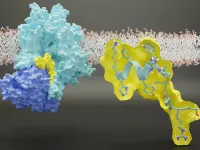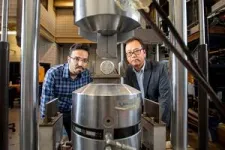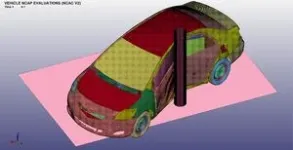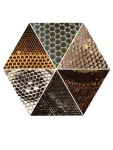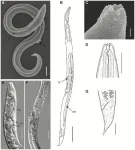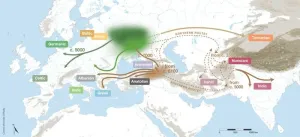(Press-News.org) Researchers at NYU College of Dentistry’s Pain Research Center have developed a gene therapy that treats chronic pain by indirectly regulating a specific sodium ion channel, according to a new study published in the Proceedings of the National Academy of Sciences (PNAS).
The innovative therapy, tested in cells and animals, is made possible by the discovery of the precise region where a regulatory protein binds to the NaV1.7 sodium ion channel to control its activity.
“Our study represents a major step forward in understanding the underlying biology of the NaV1.7 sodium ion channel, which can be harnessed to provide relief from chronic pain,” said Rajesh Khanna, director of the NYU Pain Research Center and professor of molecular pathobiology at NYU Dentistry.
Chronic pain is a significant public health issue that affects roughly a third of the U.S. population. Scientists are eager to develop pain medications that are more effective and safer alternatives to opioids.
Sodium ion channels play a key role in the generation and transmission of pain, as they are critical for nerve cells, or neurons, communicating with each other. One particular sodium ion channel called NaV1.7 emerged as a promising target for treating pain following the discovery of its importance in people with rare, genetic pain disorders. In some families, a mutation in the gene that encodes for NaV1.7 allows large amounts of sodium to enter cells, causing intense chronic pain. In other families, mutations that block NaV1.7 result in a complete lack of pain.
Scientists have been trying for years to develop pain treatments to selectively block NaV1.7—with little success. Khanna has taken a different approach: rather than blocking NaV1.7, his goal is to indirectly regulate it using a protein called CRMP2.
“CRMP2 ‘talks’ to the sodium ion channel and modulates its activity, allowing more or less sodium into the channel. If you block the conversation between Nav1.7 and CRMP2 by inhibiting the interaction between the two, we can dial down how much sodium comes in. This quiets down the neuron and pain is mitigated,” said Khanna, the PNAS study’s senior author.
Khanna’s lab previously developed a small molecule that indirectly regulates Nav1.7 expression through targeting CRMP2. The compound has been successful in controlling pain in cells and animal models, and studies are continuing towards its use in humans. But despite the compound’s success, a key question remained: why does CRMP2 only communicate with the NaV1.7 sodium ion channel, and not the eight other sodium ion channels in the same family?
In their PNAS study, the researchers pinpointed a specific region within NaV1.7 where the CRMP2 protein binds to the sodium ion channel in order to regulate its activity. They learned that this region is specific to NaV1.7, as CRMP2 did not readily bind to other sodium ion channels.
“This got us really excited, because if we took out that particular piece of the NaV1.7 channel, the regulation by CRMP2 was lost,” said Khanna.
To limit the communication between CRMP2 and NaV1.7, the researchers created a peptide from the channel that corresponds to the region where CRMP2 binds to NaV1.7. They inserted the peptide into an adeno-associated virus in order to deliver it to neurons and inhibit NaV1.7. Using viruses to transport genetic material to cells is a leading approach in gene therapy, and has led to successful treatments for blood disorders, eye diseases, and other rare conditions.
The engineered virus was given to mice experiencing pain, including sensitivity to touch, heat, or cold, as well as peripheral neuropathy that results from chemotherapy. After a week to 10 days, the researchers’ assessed the animals and found that their pain was reversed.
“We found a way to take an engineered virus—containing a small piece of genetic material from a protein that all of us have—and infect neurons to effectively treat pain,” said Khanna. “We are at the precipice of a major moment in gene therapy, and this new application in chronic pain is only the latest example.”
The researchers replicated their findings inhibiting NaV1.7 function across multiple species, including rodents and the cells of primates and humans. While more studies are needed, this is a promising sign that their approach will translate into a treatment for humans.
“There is a significant need for new pain treatments, including for cancer patients with chemotherapy-induced neuropathy. Our long-term goal is to develop a gene therapy that patients could receive to better treat these painful conditions and improve their quality of life,” said Khanna.
In addition to Khanna, study authors include Kimberly Gomez, Paz Duran, Santiago Loya, Cheng Tang, Aida Calderon- Rivera, May Khanna, and Samantha Perez-Miller of NYU Dentistry; Harrison J. Stratton, Liberty François-Moutal, Cynthia L. Madura, Shizhen Luo, Dongzhi Ran, and Lisa Boinon of the University of Arizona; Bryan McKiver, Edward Choi, and M. Imad Damaj of Virginia Commonwealth University; and Aubin Moutal of St. Louis University.
The research is supported by the National Institute of Neurological Disorders and Stroke (NS098772, NS120663, and NS119263), and National Institute on Drug Abuse (DA042852). Khanna and several co-authors are co-founders of biotech companies Regulonix LLC and ElutheriaTx Inc. to develop non-opioid drugs for chronic pain, and hold patents on the technology described in the study.
About NYU College of Dentistry
Founded in 1865, New York University College of Dentistry (NYU Dentistry) is the third oldest and the largest dental school in the US, educating nearly 10 percent of the nation’s dentists. NYU Dentistry has a significant global reach with a highly diverse student body. Visit dental.nyu.edu for more.
END
Gene therapy treats chronic pain by dialing down sodium
Scientists identified the region where a protein regulates sodium ion channels, inserting the channel’s genetic material into a virus to alleviate pain in cell and animal studies
2023-07-27
ELSE PRESS RELEASES FROM THIS DATE:
Bees and wasps independently invent the same architectural tricks
2023-07-27
At first glance, the hexagonal cells build by honey bees and social wasps may seem similar, but they are significantly different. Honey bees build using wax, whereas wasps use paper. Honey bees build their double-sided combs vertically, whereas wasps build single-sided comb horizontally (i.e., the opening of each cell faces downward).
Indeed, the hexagonal cells built by these two groups have independent evolutionary origins. Just like sharks and whales have similar body plans due to their watery environment, bees and wasps build hexagonal cells because the shape maximizes strength and storage area, while minimizing building materials.
But what happens when perfectly ...
Study finds strong support for easing Medicaid enrollment procedures
2023-07-27
During the COVID-19 pandemic, governments changed rules and procedures related to Medicaid enrollment. These changes decreased many of the burdens eligible people face when signing up for programs and contributed to a 30 percent increase in Medicaid enrollment. However, the end of public health emergency declarations brings an end to these pandemic policies, which many fear could lead to eligible people losing public health insurance simply because they are unable to fulfill administrative requirements such as accurately filling out and submitting forms, renewing their enrollment ...
MIND diet study shows 'short-term' impact on cognition
2023-07-27
New research shows the importance of long-term commitment to the MIND diet for reaping the greatest benefit to brain health.
“The benefits within the new study’s three-year clinical trial weren’t as impressive as we’ve seen with the MIND diet observational studies in the past, but there were improvements in cognition in the short-term, consistent with the longer-term observational data,” said lead study author Lisa Barnes, PhD, associate director of the Alzheimer’s Disease Research Center at RUSH.
Results from the study, published in The New England Journal of Medicine, showed that within a three-year period, there was no significant ...
Race/ethnicity isn't associated with unplanned hospitalizations after breast reconstruction
2023-07-27
July 27, 2023 – Race/ethnicity is not an independent predictor of hospital readmission in patients undergoing breast reconstruction surgery, reports a study in the August issue of Plastic and Reconstructive Surgery®, the official medical journal of the American Society of Plastic Surgeons (ASPS). The journal is published in the Lippincott portfolio by Wolters Kluwer.
Among patients who have unplanned hospitalizations after breast reconstruction, costs are substantially higher for Black or Hispanic patients, according to the new research by ASPS ...
Nematode resurrected from Siberian permafrost laid dormant for 46,000 years
2023-07-27
A soil nematode reanimated from Siberian permafrost had laid dormant for approximately 46,000 years, according to a study publishing July 27, 2023 in the open access journal PLOS Genetics by Anastasia Shatilovich at the Institute of Physicochemical and Biological Problems in Soil Science RAS in Russia, Vamshidhar Gade at the Max Planck Institute for Molecular Cell Biology and Genetics in Germany, and colleagues.
Some animals, such as tardigrades, rotifers, and nematodes, can survive harsh conditions by entering a dormant state known as “cryptobiosis”. Previously, nematode individuals were reanimated from samples collected from a fossilized burrow in silt deposits ...
New insights into the origin of the Indo-European languages
2023-07-27
For over two hundred years, the origin of the Indo-European languages has been disputed. Two main theories have recently dominated this debate: the ‘Steppe’ hypothesis, which proposes an origin in the Pontic-Caspian Steppe around 6000 years ago, and the ‘Anatolian’ or ‘farming’ hypothesis, suggesting an older origin tied to early agriculture around 9000 years ago. Previous phylogenetic analyses of Indo-European languages have come to conflicting conclusions about the age of the family, due to the combined effects of inaccuracies and inconsistencies in the datasets they used and limitations in the way that phylogenetic methods analyzed ...
Genome analysis of 46,000-year-old roundworm from Siberian permafrost reveals novel species
2023-07-27
Some organisms, such as tardigrades, rotifers, and nematodes, can survive harsh conditions by entering a dormant state known as “cryptobiosis.” In 2018, researchers from the Institute of Physicochemical and Biological Problems in Soil Science RAS in Russia found two roundworms (nematode) species in the Siberian Permafrost. Radiocarbon dating indicated that the nematode individuals have remained in cryptobiosis since the late Pleistocene, about 46,000 years ago. Researchers from the Max Planck Institute of Molecular Cell Biology and Genetics (MPI-CBG) in ...
Tau-regulating protein identified as a promising target for developing Alzheimer’s disease treatment
2023-07-27
PHILADELPHIA – A gene encoding a protein linked to tau production—tripartite motif protein 11 (TRIM11)—was found to suppress deterioration in small animal models of neurodegenerative diseases similar to Alzheimer’s disease (AD), while improving cognitive and motor abilities, according to new research from the Perelman School of Medicine at the University of Pennsylvania. Additionally, TRIM11 was identified as playing a key role in removing the protein tangles that cause neurodegenerative diseases, like AD. The findings are published today in Science. ...
A unified theory of the lexicon and the mind: Researchers find common cognitive foundation for child language development and language evolution
2023-07-27
Cognitive and computer scientists at the University of Toronto, Universitat Pompeu Fabra and the Catalan Institution for Research and Advanced Studies have found child language development and the historical evolution of the world’s languages share a common cognitive foundation—a core knowledge base where patterns of children’s language innovation can predict patterns of language evolution, and vice versa.
Published today in Science, the paper is a first-of-its-kind step toward a unified theory of the lexicon and the mind examined across timescales. The result may also help predict how a word’s meaning may change ...
Exposure to like-minded sources on Facebook is prevalent but did not increase polarization during the 2020 U.S. election
2023-07-27
People often debate whether social media creates "echo chambers" by showing users content that matches their politics and in turn increases polarization. A new study published today in the journal Nature reports that reducing Facebook users' exposure to content from politically "like-minded" sources had no measurable effect on their political beliefs or attitudes during the 2020 U.S. presidential election.
The findings are part of a broader research project examining the role of ...
LAST 30 PRESS RELEASES:
The Lancet Obstetrics, Gynecology, & Women’s Health: Taking paracetamol during pregnancy does not increase risk of autism, ADHD or intellectual disabilities, confirms new gold-standard evidence review
Taking paracetamol during pregnancy does not increase risk of autism, ADHD or intellectual disabilities
Harm reduction vending machines in New York State expand access to overdose treatment and drug test strips, UB studies confirm
University of Phoenix releases white paper on Credit for Prior Learning as a catalyst for internal mobility and retention
Canada losing track of salmon health as climate and industrial threats mount
Molecular sieve-confined Pt-FeOx catalysts achieve highly efficient reversible hydrogen cycle of methylcyclohexane-toluene
Investment in farm productivity tools key to reducing greenhouse gas
New review highlights electrochemical pathways to recover uranium from wastewater and seawater
Hidden pollutants in shale gas development raise environmental concerns, new review finds
Discarded cigarette butts transformed into high performance energy storage materials
Researchers highlight role of alternative RNA splicing in schizophrenia
NTU Singapore scientists find new way to disarm antibiotic-resistant bacteria and restore healing in chronic wounds
Research suggests nationwide racial bias in media reporting on gun violence
Revealing the cell’s nanocourier at work
Health impacts of nursing home staffing
Public views about opioid overdose and people with opioid use disorder
Age-related changes in sperm DNA may play a role in autism risk
Ambitious model fails to explain near-death experiences, experts say
Multifaceted effects of inward foreign direct investment on new venture creation
Exploring mutations that spontaneously switch on a key brain cell receptor
Two-step genome editing enables the creation of full-length humanized mouse models
Pusan National University researchers develop light-activated tissue adhesive patch for rapid, watertight neurosurgical sealing
Study finds so-called super agers tend to have at least two key genetic advantages
Brain stimulation device cleared for ADHD in the US is overall safe but ineffective
Scientists discover natural ‘brake’ that could stop harmful inflammation
Tougher solid electrolyte advances long-sought lithium metal batteries
Experts provide policy roadmap to reduce dementia risk
New 3D imaging system could address limitations of MRI, CT and ultrasound
First-in-human drug trial lowers high blood fats
Decades of dredging are pushing the Dutch Western Scheldt Estuary beyond its ecological limits
[Press-News.org] Gene therapy treats chronic pain by dialing down sodiumScientists identified the region where a protein regulates sodium ion channels, inserting the channel’s genetic material into a virus to alleviate pain in cell and animal studies
